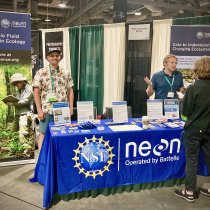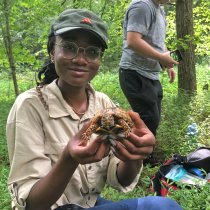Case Study
NEON Data Enables New Research Opportunities at SERC
March 16, 2018
The Smithsonian Environmental Research Center (SERC) has been collecting ecological data on coastal ecosystems in the Chesapeake Bay area for more than 50 years. Now, it is the home to a NEON terrestrial field site, also named SERC, which includes a 204' tall flux tower, and an array of soil sensors and observational sampling plots. The NEON Airborne Observation Platform (AOP) will also collect remote sensing data across SERC properties throughout the lifetime of the NEON project. Hosting a NEON field site gives SERC scientists access to new local data as well as important comparative data from across the country to further their research goals.
Dr. Geoffrey (Jess) Parker is one of these scientists. A Forest Ecologist at SERC, Jess will be using NEON data to extend his studies of tree growth and the exchange of carbon, energy and moisture between forests and the atmosphere.
SERC: A Long and Storied History of Ecological Research
SERC was founded in the 1960s after Mr. Robert Lee Forrest, a Maryland dairy farmer, left the Smithsonian 368 acres of land and a large sum of money in his will. Recognizing the potential of the property to support valuable ecological research, the Smithsonian established the Chesapeake Bay Center for Field Biology on the site in 1965. Further endowments and land acquisitions have since expanded the site to 2,650 acres encompassing a variety of terrestrial, wetland and estuarine habitats. The center was renamed SERC in 1985.
With its long history and extensive land holdings, SERC is one of the nation’s premier ecological research centers. SERC now supports 180 full time field researchers and staff members, including 17 principal investigators, and hosts dozens of graduate students, interns and visiting researchers each summer. These scientists have amassed a large and valuable collection of ecological data that is helping to answer fundamental questions about how these ecosystems have changed over the decades in response to land use patterns, invasive species and changing climates.
Bringing NEON Data to SERC Scientists
The NEON field site at SERC’s central campus was one of the first in the NEON network to become fully operational. The flux tower was erected in 2016 and outfitted with a full suite of atmospheric sensors as well as two phenocams. Battelle field ecologists have been conducting observational sampling since 2015 of mosquitoes, ticks, ground beetles, breeding landbirds, plants, and soil microbes within the tower airshed and throughout the greater SERC property. NEON’s AOPs collect LIDAR, hyperspectral and digital camera imagery during peak vegetation greenness semi-annually.
One of the key benefits of the NEON data is the ability to compare across NEON field sites. The NEON project provides a supportive infrastructure that enables standardized, high-quality data collection. This allows Jess and other SERC scientists to compare their data to data collected at other NEON sites to see how patterns they are seeing in Maryland compare to changes seen in other ecosystems across the continent. It will also provide greater data continuity over time, with a consistent infrastructure and data collection protocols that are not dependent on shifting funding sources or the idiosyncratic interests of individual researchers.
Jess explains, “With NEON, the era of Big Science has arrived in ecology. Just as large shared projects like the Large Hadron Collider (LHC) and the Hubble Telescope have dramatically advanced particle physics and astronomy, the NEON network of field sites provides a shared infrastructure that will take ecology to the next level.”
Monitoring Forest Growth Across the Decades
Jess has been conducting forest research with SERC for more than 30 years. His primary research focus is on forest canopies and how the organization and structure of the canopy influences the exchange of gases, energy and moisture, measurements known as atmospheric flux or eddy covariance.
As part of this research, he has been collecting tree map data at the site and using flux measurements from an older atmospheric tower located at SERC. The older flux tower was part of a network called AmeriFlux, a community of sites collecting and sharing eddy covariance data across the Americas to further our understanding of how different ecosystems exchange energy and materials (such as water vapor and carbon dioxide) with the atmosphere. Some of these data were contributed to the ForestGEO Network, a voluntary collaboration of about 60 sites around the world that share and compare forest map data.
These voluntary networks have been critical for Jess and other researchers studying forest ecology, enabling comparison of data across different geographic regions. However, the data collected in such cooperative efforts has been very much subject to changes over time in funding and the priorities of local researchers. The addition of NEON’s field site at SERC will provide consistent, high-quality data for the next three decades that will enable Jess and other researchers to better monitor changes across time and between SERC’s site and others across the continent.
Watching the Forest Breathe
The new data products provided by the NEON field sites will build on Jess’s previous research and help him answer fundamental questions about how forest ecosystems are changing. Because the new NEON tower is at the same location and collects similar data as the older AmeriFlux tower, it will ensure continuity with his existing 30 years of data while providing new data products that offer added depth. In particular, it will extend the range of time scales for understanding how forests change. SERC has studies spanning 250 years of forest succession with plot-based work covering the decadal scale. The eddy covariance measurements from the NEON tower provide data down to 30-minute scale. Jess says, “This adds a whole new time scale to our data collection. We can actually see the forest breathing, and see how the exchange of gases, water and energy changes across the course of a day and under different atmospheric conditions.”
He is especially excited about the addition of airborne remote sensing data. The NEON AOP will provide detailed measurements of key structural and reflective measurements of the forest canopy, including canopy height and topography, tree growth patterns, vegetation type, Leaf Area Index (LAI), canopy chemistry (e.g., nitrogen) and other measures. Jess hopes to connect these data with data he has collected on the ground and with the flux tower data to gain new insights into how canopy characteristics impact the ability of a forest to sequester carbon, among other questions. Discovering these kinds of correlations would enable ecologists to extrapolate carbon sequestration potential and other key indicators from nationwide remote sensing data, providing a much clearer picture of how atmospheric exchange patterns are changing on a continental scale.
A Showcase for Ecological Research
Jess’s research is just one example of the ways that SERC scientists are using NEON data. As more data products become available on the NEON website, they will help SERC researchers answer critical questions in ecology for decades to come.
Jess currently serves as a liaison between SERC and the NEON project team. During the construction phase, he helped coordinate NEON activities with the needs of SERC researchers and the local community. He continues to work with other researchers who want to take advantage of NEON data or collect additional data from the area on their own. He says SERC’s location just outside Washington D.C. has also made the site an attraction for policy makers, journalists, citizen groups and visiting scientists who want to learn more about the NEON project and the importance of the ecological research that NSF and SERC are conducting.
Moving forward, Jess is excited about the potential of the NEON-SERC collaboration. “There are some obvious benefits that will come out of this new data, but there will also be a lot of surprises,” he says. “I can’t wait to see what we will learn from these measurements over the coming years. NEON’s data will allow us to answer fundamental questions about ecology and also to ask new questions.”



